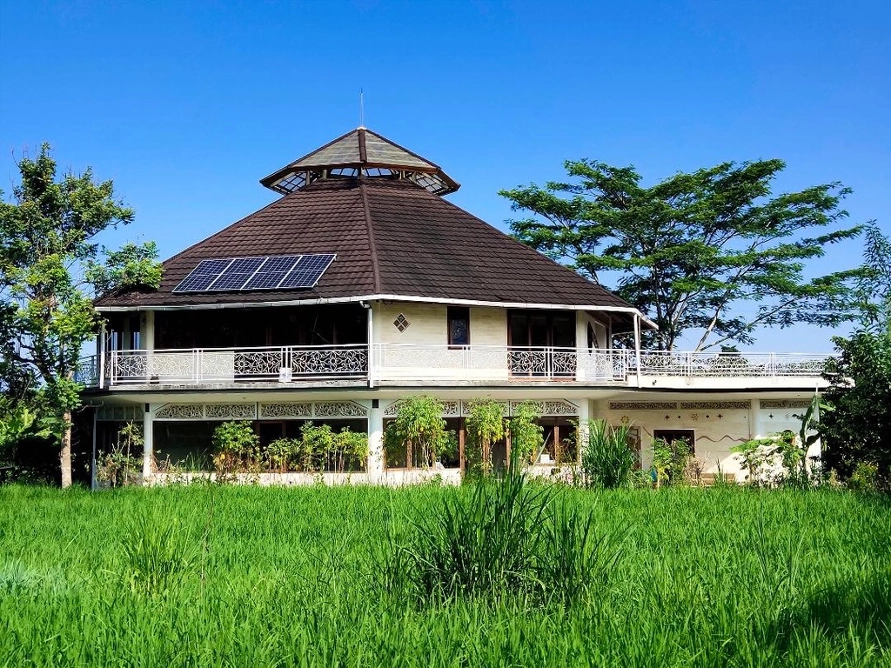Education serves as the foundation for a bright future, moulding young minds into confident and capable individuals. For expatriates relocating to Bali with their families, providing their children with a top-notch education is a priority. Fortunately, there is an array of international schools in Bali that provide exceptional education customised to cater to the diverse requirements of students from different parts of the world. These institutions guarantee that every young learner experiences the utmost quality in both academic and personal growth opportunities.
1. Spark Bali
Spark Bali stands out as a hub of innovative education tailored for teenage learners. Its goal is to go beyond the usual classroom limits, believing in an approach that focuses on skills rather than rigid age groups. At Spark Bali, classes are intentionally small, typically having around five students with a maximum of eight. This ensures teachers provide personalised attention to each student, creating an environment where progress is based on actual skills, not just age.
Moreover, this international school in Bali integrates the globally recognized Cambridge Curriculum with Project Based Learning, providing a dynamic educational experience that prepares students for Cambridge IGCSE examinations and real-world challenges. At this institution, English is the primary language of instruction. However, it also offers Bahasa Indonesia to assist non-native speakers in their learning journey.
Spark Bali welcomes students aged 12 to 17, with classes from 8:50 AM to 3:25 PM, Monday to Thursday. Fridays are reserved for focused tuition sessions tailored to individual needs. Beyond academics, it provides diverse extracurricular activities like music, sound production, skateboarding, as well as Dungeons and Dragons club. Its facilities promote holistic development, including lunch menus, specialised rooms for various interests, and even a skate park to support physical expression and creativity.
Located at Jalan Raya Sibang Kaja, Badung, Spark Bali is an intimate international school with annual fees starting from Rp54 million, reflecting its dedication to providing affordable, high-quality education.
2. Dyatmika School
Dyatmika School is a symbol of outstanding education in Bali, with a vision to nurture confident, academically thriving individuals who are not just learners but thinkers and problem-solvers. It focuses on developing well-rounded individuals, teaching positive values, civic responsibility, and deep respect for the community as well as the environment. At the same time, it cherishes and preserves the rich cultural heritage of Bali.
This international school in Bali follows the Cambridge Curriculum complemented by Indonesian cultural studies, offering students from the ages of 3 to 18 a comprehensive educational pathway that leads to Cambridge IGCSE, AS Level, and A-Level qualifications. English is the medium of instruction with expert native teachers, and language support is in place to assist those who are still mastering the language.
The school day starts at 8 Am and ends at 2:45 PM, providing a structured yet flexible schedule that supports academic achievement and personal development. Extracurricular activities are abundant at Dyatmika, ranging from community gardening and traditional Balinese language classes to modern pursuits like rock bands, Python coding, and sports. The facilities include a school bus service, a library, and extensive fields for outdoor activities. Furthermore, the school’s commitment to student welfare is exemplified by the on-site licensed educational psychologist, affiliated with the Indonesian Psychological Association.
With class sizes capped at 22 students, personal attention is a given, fostering an environment where each learner can flourish. Dyatmika School is located in Jalan Pucuk Bang, Denpasar, with annual fees ranging from Rp42 million to Rp123 million, ensuring a broad spectrum of families can access top-tier international education.
3. Sekolah Montessori ERDKINDER Bali


In the peaceful outskirts of central Ubud, surrounded by rice paddies and organic farms, Sekolah Montessori ERDKINDER Bali offers a comprehensive education based on the Montessori philosophy. The school’s bio-architectural octagonal building is a testament to its commitment to sustainability and a nurturing learning environment. Here, respect, love, grace, courtesy, and independence are not merely values; they are the pillars of education.
The ERDKINDER curriculum follows the Montessori framework that emphasises respect for each child’s uniqueness. This school understands the needs of Indonesian students facing government exams and, at the same time, offers an optional homework approach that respects a child’s interest in extending learning beyond the classroom.
This international school in Bali supports children with special learning needs and provides the option of a personal assistant for an additional fee, ensuring that every child has the opportunity to thrive. Class sizes remain intimate, with an average of 10 students, allowing for individualised attention.
With extracurricular activities that include traditional Balinese dance and music lessons, ERDKINDER balances academic pursuits with cultural and artistic expression. Facilities like a school farm and playground enrich the student’s educational experience. This top-notch international school is transparent with its fee structure, ranging from Rp60 million to Rp70 million per annum.
4. Singaraja Montessori School
The Singaraja Montessori School (SMS) is a sanctuary of learning that embraces the Montessori Method, renowned for its child-centric approach to education. At SMS, the mission is clear: to create a world-class educational environment that encourages children to be active learners through hands-on experiences. The bilingual setup ensures that Indonesian culture and language are at the forefront while also giving due importance to the English language, helping students to become global citizens.
SMS takes a unique approach to education, steering clear of traditional examinations and homework. Instead, this international school in Bali encourages young minds to learn through exploration and interaction with their surroundings. This philosophy fosters independence and confidence, allowing children to develop at their own pace without the usual pressures of traditional schooling.
Nestled in Jalan Gn. Rinjani, Buleleng, SMS offers a rich tapestry of extracurricular activities, including Balinese dance and yoga, which complement the academic curriculum and contribute to the development of well-rounded individuals. This school does not publicly disclose its fees, reflecting its inclusive and discrete approach to education.
5. Skywalker Academy
Skywalker Academy, established in 2017, promises a unique and effective blend of traditional and modern educational techniques, all while fostering positive and sustainable human relationships. At Skywalker, the British curriculum provides a structured framework for students as they prepare for the prestigious Cambridge IGCSE and A-Level examinations.
Languages play a vital role at this international school in Bali with English as the medium of instruction and Indonesian for those wishing to deepen their cultural ties. The school’s day runs from 8:30 to 4 PM, and extracurricular activities range from arts to sports, ensuring a well-rounded development.
Skywalker Academy’s facilities are crafted to meet all needs, offering a diverse lunch menu to cater to various dietary requirements and a variety of outdoor spaces for students to enjoy. Class sizes typically range around 15, never exceeding 18, ensuring individualised attention on each student’s educational journey. Located in Buwit, Tabanan, Skywalker Academy keeps its fees private, ensuring a discrete process for prospective parents.
6. Green School Bali


Conceived by John and Cynthia Hardy in 2006, Green School Bali is an educational oasis where sustainability and entrepreneurial learning take centre stage. This wall-less, natural environment is more than a school; it’s a movement towards a greener future.
Offering an international curriculum culminating in the Green School Diploma, English is the primary language of instruction, supported by additional Indonesian and French classes. The school day begins at 8:15 AM and concludes at 3:15 PM, with a dynamic range of extracurricular activities on offer.
Green School’s facilities are a testament to its commitment to sustainability, featuring gardens and a yoga studio among others. With class sizes averaging 20 and capping at 22, the school fosters community and individual growth. Annual fees range from Rp163 million to Rp302 million, reflecting the comprehensive experience it offers.
7. Lycée Francais de Bali
As part of the AEFE network, Lycée Francais de Bali has been providing French education since 1991. The school embraces a learning approach that combines play, discovery, and experience. French is the main language of instruction, complemented by English, Indonesian, Spanish, and Chinese.
Students are prepared for certifications like DELE and IELTS, useful for international university admissions. The school day spans from 7:50 AM to 3:30 PM, packed with extracurricular activities from volleyball to surfing, nurturing students in every aspect.
With facilities including a gymnasium and science lab, the Lycée Francais de Bali caters to all facets of student development. Class sizes maintain an intimate setting for learning, averaging 20 students and peaking at 25. The yearly fees range from Rp54 million to Rp145 million, offering various options for families.
In choosing the right international school in Bali, consider the unique ethos and curriculum each institution offers. Assessing factors such as teaching methodologies, extracurricular activities, and the overall learning environment can help ensure a tailored educational experience for your child, fostering both academic growth and personal development.








One comment
JeremyCib
November 19, 2024 at 3:04 pm
static balancing machines
In the world of machinery and equipment, static balancing machines serve as critical devices that ensure optimal operation of various rotating components. These machines play a vital role in industries where precision, performance, and durability are of utmost importance. When it comes to rotating machinery such as fans, turbines, and augers, ensuring balance is essential for maintaining performance and extending the life of the equipment.
Understanding Static Balance
Static balance occurs when an object remains at rest, yet its center of gravity is not aligned with its axis of rotation. This imbalance typically results from uneven distribution of mass. In the case of static balancing machines, the goal is to correct this imbalance by adding or removing mass at predetermined locations on the rotor. This adjustment ensures that the center of gravity coincides with the axis of rotation, eliminating unwanted motion.
Importance of Static Balancing Machines
Static balancing machines are particularly advantageous in applications involving narrow, disk-shaped rotors. Industries that rely on these machines include manufacturing plants, aerospace, automotive, and energy production. By effectively utilizing static balancing techniques, businesses can avert excessive wear and tear, reduce maintenance costs, and enhance the performance and longevity of their machines.
Static vs. Dynamic Balancing
While static balancing addresses the weight distribution in a stationary rotor, dynamic balancing focuses on correction methods when the rotor is in motion. Dynamic imbalance arises when the rotor contains unbalanced masses located in different planes, affecting the rotational motion and introducing vibrations. Understanding the distinction between static and dynamic balancing is crucial in selecting the appropriate method for machinery maintenance and optimization.
How Static Balancing Machines Work
The operation of static balancing machines involves various steps to ensure the rotor achieves equilibrium. Initially, the rotor is mounted securely in the balancing machine, where vibration sensors are used to measure any existing imbalances. Based on these measurements, operators can identify where corrective weights need to be added or removed.
Once the trial weights are installed, operators run the rotor to observe any changes in vibration. Measurements are analyzed, and adjustments are made until the vibrations are reduced to acceptable levels, indicating a successful balance. The precision provided by static balancing machines allows industries to maintain seamless operations and efficient machinery function.
Applications of Static Balancing Machines
Static balancing machines are versatile tools that find applications in numerous fields. They are instrumental in ensuring that everyday machinery operates smoothly, enhancing the user experience and product quality. The power of these machines can be seen in a variety of applications, including:
Aerospace Engineering: Static balancing is crucial in ensuring that aircraft components achieve proper balance, thereby ensuring safety and efficiency in flight operations.
Automotive Manufacturing: Vehicles rely on expertly balanced rotors to minimize vibrations and enhance ride quality.
Energy Production: Turbines used in different energy sectors benefit from balancing machines, which promote effective energy conversion and output.
Manufacturing Machinery: Industry-standard equipment such as fans, crushers, and augers require balance to minimize operational vibrations and extend service life.
Benefits of Using Static Balancing Machines
Employing static balancing machines offers numerous benefits, including:
Improved Performance: Properly balanced machinery operates more efficiently, leading to increased productivity.
Reduced Maintenance Costs: Preventing imbalances that could lead to equipment failure extends the lifespan of machinery and minimizes costly repairs.
Enhanced Safety: Balanced machinery reduces the risk of accidents caused by equipment malfunction.
Noise Reduction: By ensuring that machinery operates without excessive vibration, static balancing machines contribute to lower noise levels in workplaces.
Conclusion
Static balancing machines play an indispensable role in modern engineering practices. They not only ensure that machinery operates optimally but also drive productivity while minimizing maintenance issues. As industries continue to demand higher performance and reliability from their equipment, the significance of static balancing machines will only grow. By investing in this technology, businesses can secure their operational efficiency and maintain a competitive edge in their fields.
Get Started with Static Balancing Machines
For those looking to enhance their machinery’s performance and longevity, exploring static balancing machines is crucial. Whether you are involved in manufacturing, energy production, or any other industry that utilizes rotating machinery, these machines can make a significant impact. Don’t wait to optimize your operations—invest in static balancing today and enjoy the benefits of smooth, noise-free, and efficient machinery.